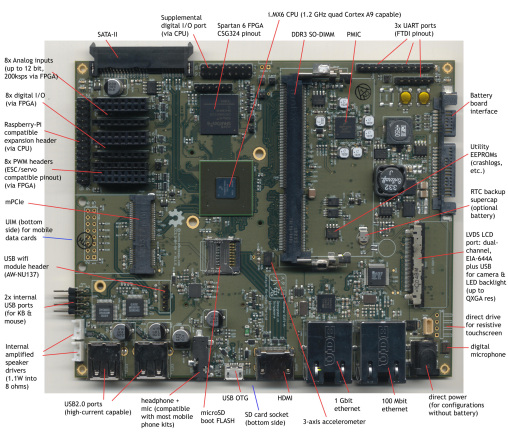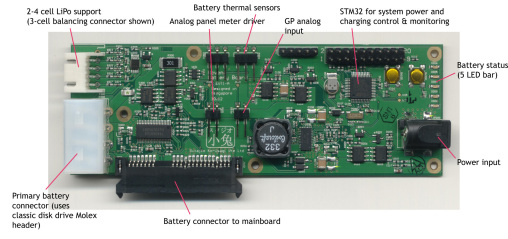Chumby developer building open source laptop
Andrew 'bunnie' Huang has announced he is planning to build a DIY laptop from openly documented hardware in an effort currently codenamed "Novena". Open hardware means that there are no licensing fees for circuit diagrams and specifications. Whilst the open source movement has been well established in the software field for some years, open hardware is still something of a rarity in the PC component field. The project plans to make a system that works with both open source hardware and software.
Huang made his name as one of the first Xbox hackers and the developer of Chumby. Huang wants to make it possible for other enthusiasts to build and modify his laptop design, to which end he and his team have manufactured a motherboard using only hardware with open source specifications and drivers. The name Novena is derived from a Singapore underground station.

![]() Overview of Novena motherboard components.
Overview of Novena motherboard components.
Source: Kosagi.com - CC BY-SA 3.0
The board uses a Freescale iMX6 CPU with four 1.2 GHz Cortex A9 cores. Graphics are dealt with by a Vivante GC2000 GPU. The laptop's ports and specifications are comparable to other netbooks and are about average – up to 4 GB DDR3-1066 SO-DIMM RAM, a SATA II port, USB 2.0 ports, HDMI output and mini-PCI Express. A dual channel LVDS LCD port is able to deliver QXGA resolution with 2048×1536 pixels at 60 Hz.
Hardware hackers will, however, find the "fun features" much more interesting. A second Ethernet port allows the laptop to be used as a packet filter (firewall) or router. USB-to-go allows the laptop to run as an Ethernet, serial spoofer/fuzzer or to connect to a computer as a USB device. The laptop also contains a Spartan-6 CSG324 packaged FPGA, plus eight analogue and eight digital FPGA inputs/outputs and another eight PWM headers for directly connecting RC motors or servos. It is also has a Raspberry Pi compatible expansion header.

![]() A daughterboard provides the power supply for the main Novena board.
A daughterboard provides the power supply for the main Novena board.
Source: Kosagi.com - CC BY-SA 3.0
Information on progress and the status of the project can be found on the project wiki. The current goal is to develop open source firmware, so that the laptop's software drivers are also open source. On the hardware side, the first prototype motherboards were produced back in June. Power management has been off-boarded to a daughterboard, which uses standard 2S1P or 4S1P type LiPo batteries. Huang is also looking forward to designing the first prototype case for the board and a later "rev-2" case in ABS and aluminium, and possibly wood and brass.
If there is enough interest, Huang is considering starting a Kickstarter campaign a few months down the line, once the components have been adequately tested. The aim, however, is not to produce a cheap laptop – for Huang, it's more about the exclusivity of a handmade product of this kind and it would be priced to reflect that.
(djwm)
![Kernel Log: Coming in 3.10 (Part 3) [--] Infrastructure](/imgs/43/1/0/4/2/6/7/2/comingin310_4_kicker-4977194bfb0de0d7.png)

![Kernel Log: Coming in 3.10 (Part 3) [--] Infrastructure](/imgs/43/1/0/4/2/3/2/3/comingin310_3_kicker-151cd7b9e9660f05.png)
















